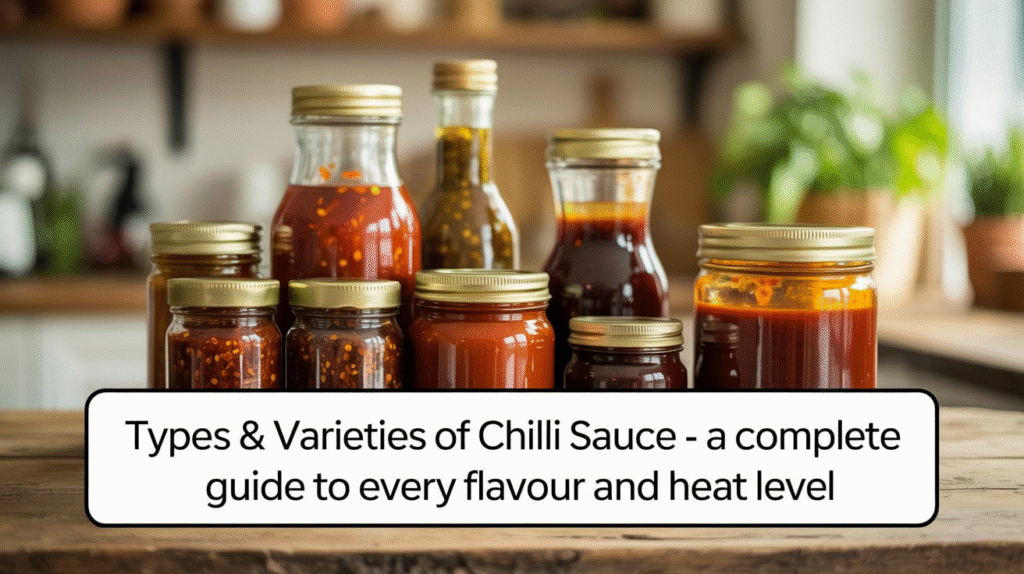Affiliate Disclosure: PantryBrands.co.uk is a participant in the Amazon.co.uk Associates Programme. As an Amazon Associate, we earn from qualifying purchases made through links on this site.
Chilli sauce comes in a wide range of types and varieties, each offering its own unique blend of heat, flavour, and texture. From sweet and tangy Asian sauces to vinegar-forward American hot sauces, understanding these differences helps you choose the best one for your meals. Here’s a breakdown of the major chilli sauce varieties available globally, and how to use them properly.

What Makes Chilli Sauces Different?
While all chilli sauces share a base of chilli peppers, they vary significantly in terms of ingredients, processing, regional origin, and intended use.
Factors That Define a Chilli Sauce Variety
Key elements that separate one chilli sauce from another include:
- Chilli type used – From jalapeños to ghost peppers, each chilli offers distinct heat and flavour.
- Additional ingredients – Sugar, vinegar, garlic, fruit, or fermented elements all impact taste.
- Texture – Sauces range from thick and jammy to thin and pourable.
Popular Types of Chilli Sauce by Region
Chilli sauces are shaped by local cuisines. Below are the most widely used varieties around the world.
Asian-Style Chilli Sauces
These sauces balance sweetness and heat and are often used in stir-fries or as dips.
- Sweet Chilli Sauce (Thailand): Mellow heat with sugar and garlic, perfect for spring rolls.
- Sambal Oelek (Indonesia): Chunky, raw chilli paste with intense heat.
Caribbean & African Chilli Sauces
Known for bold heat and fruity undertones, these sauces often feature tropical ingredients.
- Scotch Bonnet Pepper Sauce: Hot and tangy, sometimes mixed with mustard or mango.
- Piri Piri Sauce (Mozambique/Portugal): Combines chillies, garlic, lemon, and herbs.
American Hot Sauces
Usually thinner, vinegar-based, and highly acidic, these are designed for dashing or drizzling.
- Louisiana Hot Sauce: Simple blend of aged peppers, vinegar, and salt.
- Chipotle Sauce: Smoky and rich, made with smoked jalapeños and tomato or adobo.
Indian Chilli Sauces & Pickles
Often made into chutneys or spicy condiments for curries and rice dishes.
- Chilli Garlic Sauce: Intense and slightly oily with a strong garlic punch.
- Mirchi Ka Achaar: Pickled chillies with spices and mustard oil.
Chilli Sauce Varieties by Flavour Profile
The flavour of chilli sauce can range from sweet and fruity to savoury and smoky.
Sweet and Fruity Sauces
Ideal for dipping or glazing meats.
- Often made with added sugar or fruit like mango or pineapple.
- Balanced heat and acidity make them family-friendly.
Savoury and Umami-Rich Sauces
Best used in cooking or as table condiments.
- Ingredients like garlic, fish sauce, or soy give depth.
- Often found in Asian or fusion cuisine.
Smoky and Fermented Sauces
Add complexity to grilled or roasted dishes.
- Use smoked chillies like chipotle or fermentation techniques.
- Offer longer shelf life and deeper flavour.
Choosing the Right Sauce for the Occasion
Each type of sauce suits specific dishes and cooking styles.
Best for Dipping and Appetisers
Choose milder sauces with a smooth texture for universal appeal.
- Sweet chilli sauce with fried snacks.
- Garlic chilli sauce with dumplings or skewers.
Best for Cooking and Marinades
Use bold, thick sauces that can hold up to heat.
- Sambal in stir-fries or curries.
- Piri piri as a chicken marinade.
Best for Drizzling and Finishing
Go for sharp, acidic sauces to wake up rich or fried foods.
- Louisiana hot sauce on chips or eggs.
- Scotch bonnet sauce on grilled meat.
Heat Levels: Mild to Extremely Hot
Understanding the heat scale helps you select the right variety.
Mild Sauces
- Suitable for children or spice-sensitive diners.
- Usually contain sugar, fruit, or sweet peppers.
Medium Heat
- Well-balanced, suitable for most people.
- Adds flavour without overwhelming the palate.
High and Extreme Heat
- Use with caution, especially if made with ghost or reaper peppers.
- Often used by enthusiasts for wings, burgers, or dares.
Tips for Using and Storing Different Types of Chilli Sauce
Different varieties have different storage needs and best usage practices.
Usage Tips
- Stir well before using as natural ingredients may separate.
- Add gradually to find your ideal heat level.
Storage Advice
- Refrigerate after opening unless labelled shelf-stable.
- Fermented sauces often last longer at room temperature.
FAQs About Types & Varieties of Chilli Sauce
Here are some questions and answers about the various types and uses of chilli sauce.
What’s the difference between hot sauce and chilli sauce?
Hot sauce is often thin, vinegar-based and very spicy. Chilli sauce is usually thicker and can range from sweet to spicy, depending on the ingredients.
Which chilli sauce is best for beginners?
Sweet chilli sauce or garlic chilli sauce are great starting points, offering mild heat and a flavour boost without being overpowering.
Are fermented chilli sauces better for gut health?
Fermented sauces contain natural probiotics, but usually in small amounts. They do offer deeper flavour and longer shelf life.
What chilli sauce is best for stir-fry?
Sambal or garlic-based chilli sauces work best in stir-fries, offering strong heat and savoury balance.
Can I mix different types of chilli sauce?
Yes, combining sauces (like sweet chilli with a touch of hot sauce) can create a balanced, customised flavour.
